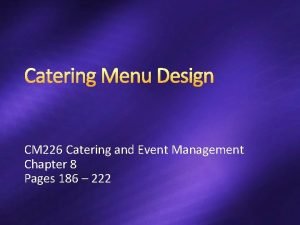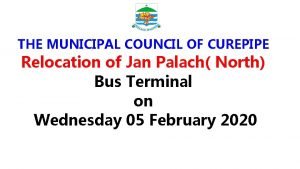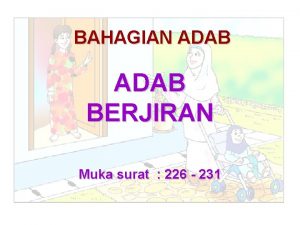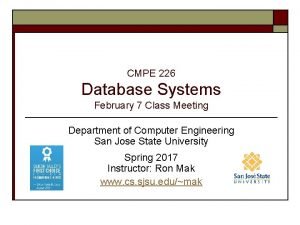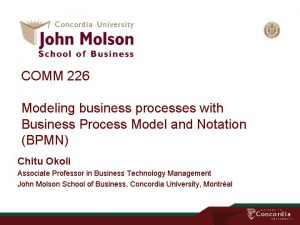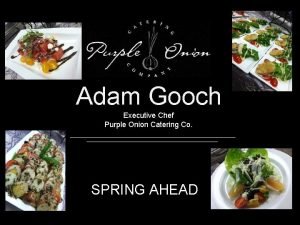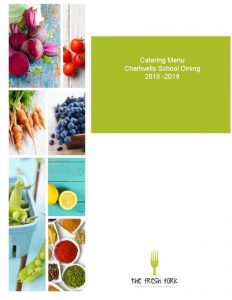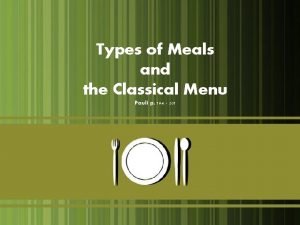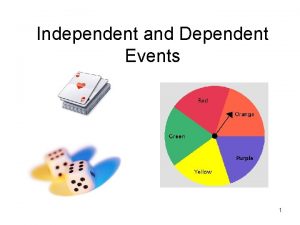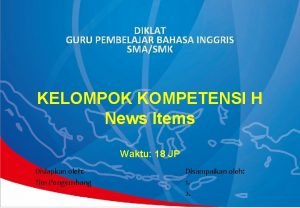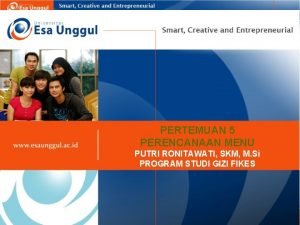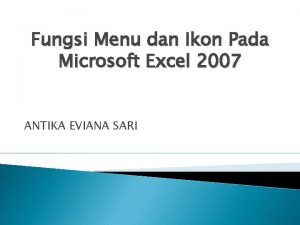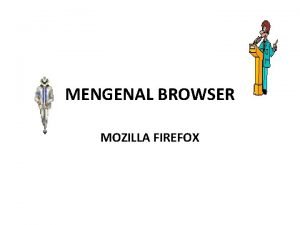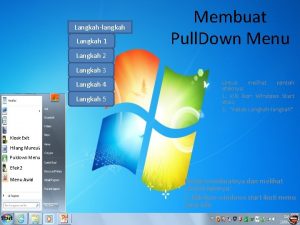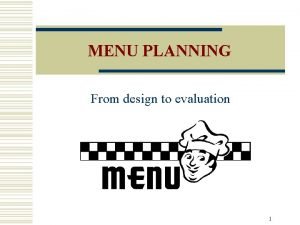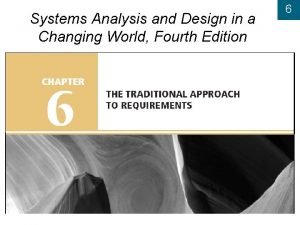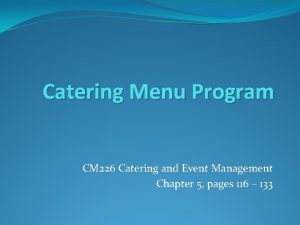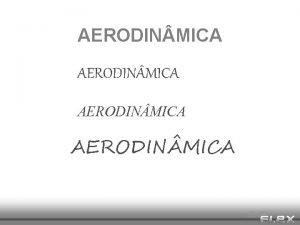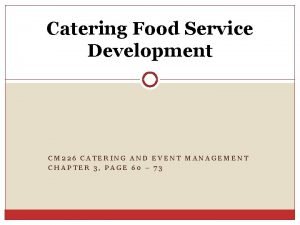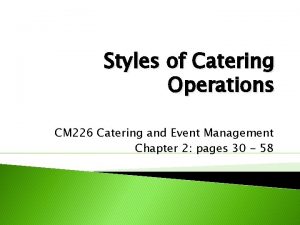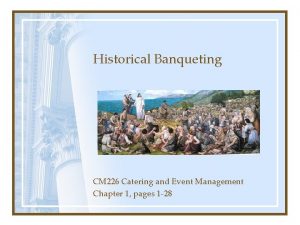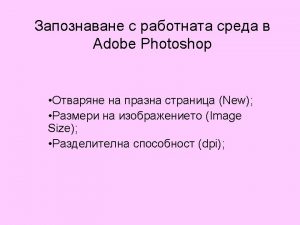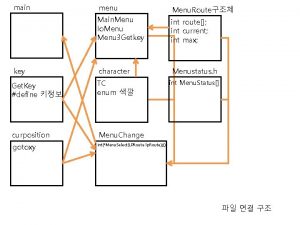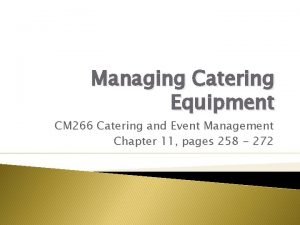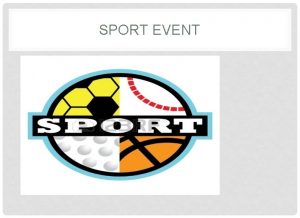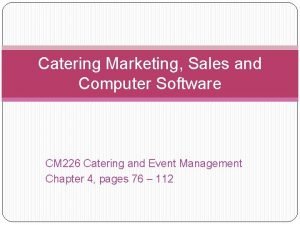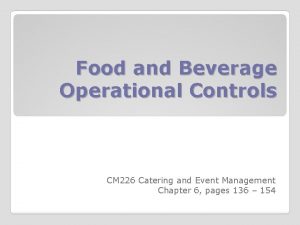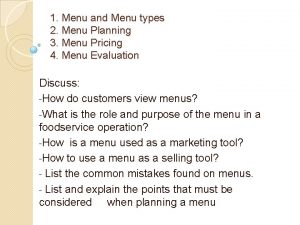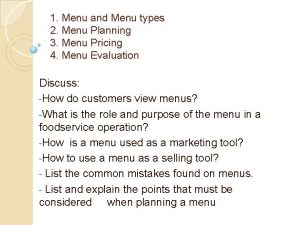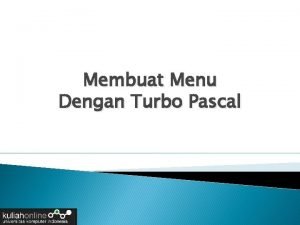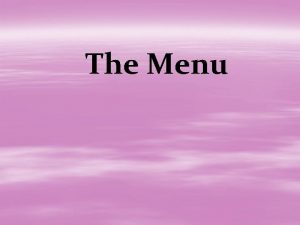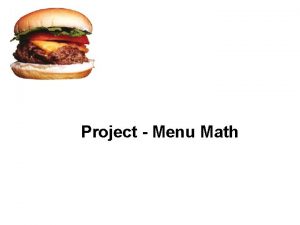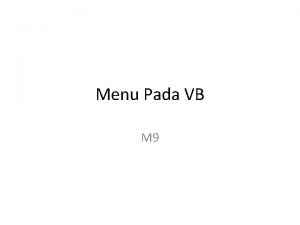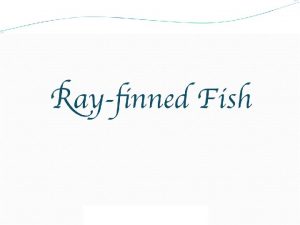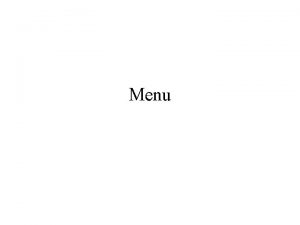Catering Menu Design CM 226 Catering and Event
























- Slides: 24

Catering Menu Design CM 226 Catering and Event Management Chapter 8 Pages 186 – 222

Chapter Objectives 1. Discuss the influences of design in the presentation of menus. 2. Explain the various catering menus and sales presentation folders that illustrate specific design elements. 3. Discuss options for placement of typeface and illustrations on the design format (layouts) 4. Identify different choices of paper stock and colors. 5. Discuss guidelines for the selection of typeface style and size in the menu layout

Menus and Sales Presentation Design The sales presentation folder includes a number of design elements: Package cover Design format Layout Typeface Paper and color Illustration and graphic design Copy

Menus and Sales Presentation Design The choice of catering menus is given considerable thought and is often conducted by a committee. In many instances, catering menus are reviewed by customers in their homes or offices without the assistance of a catering sales representative.

Sales Presentation Covers The design format of catering menus and services is often shaped by the presentation cover. It is an optional design piece used to present contacts, correspondence, menus, and other information. The most common format is a two-panel cover measuring 9 by 12 inches.

Sales Presentation Covers The cover usually has pocket flaps inside that hold materials in place. Due to their cost, package cover sizes and shapes that use die cuts in their design are generally limited to conference and convention centers and hotels. Individual catering businesses do not often invest in the design and printing expenses required for these presentations.

Menu Design Format The most traditional is the basic single-panel page. Index format Two panel fold Single panel Multi page Vertical multi panel Die cut multi page Seven panel

Layout. The placement of typeface and illustrations on the design format. Many catering services use computer word processing programs to produce their own menus.

Typeface: the 4 Areas Typeface style and size can influence the customer’s choice of menu. Customers pass over or skim and discard menus that are difficult to read.

Typeface: Area 1 Course headings separate the menu items into sections such as appetizer, entrée, and dessert. The primary use of typeface for this section is to create interest and unify the overall design. Readability is not a major concern here.

Typeface: Area 2 Menu item names must stand out on the menu page. The primary function of typeface in this section is to highlight menu items in a style that is easy to read and comfortable for the eyes.

Typeface: Area 3 Descriptive copy identifies menu item ingredients and provides other information of interest to customers. Typeface should be easy to read and a different style or weight than the menu item typeface.

Typeface: Area 4 Merchandising copy provides catering service and special interest information. Merchandising copy is usually placed at the page bottom or on separate panels or pages.

Paper and Color Explain different types of paper stock (lightweight and heavy weight). Color can be used in catering menus to elicit specific physical and emotional actions from the reader.

Illustration and Graphic Design Catering menus that use illustration are highly successful. The marketing objectives of creating interest, reinforcing theme, and directing customer attention can be achieved with illustration and graphic design.

Copy is the written words that identify menu items and describe item contents for the customer. The three categories: Accent copy Descriptive item copy Merchandising copy

Accent Copy is used in course headings and menu-item names to create customer interest. In catering menus, accent copy, particularly foreign-language terms, can help establish themes and reinforce cuisine orientation. Historical reference and humor are other tools of accent copy.

Descriptive Item Copy Descriptive-Item Copy informs the customer about the contents of the menu items. It is important, especially in catering menus, to keep this descriptive s brief as possible. Ingredients that are highlighted by descriptive copy should encourage the selection of the men item by creating interest or emphasizing the quality of preparation.

Descriptive Item Copy Descriptive copy should maximize the use of ingredients to create customer interest with phrases such as “fire weed honey, ” brown sugar glazed mango ginger, ’ “caramelized Alsatian apple, ” and sundried cherry cabernet. ” Detailed sentences that over describe menu items are inappropriate for catering menus.

Descriptive Item Copy Words such as crisp, fluffy, light, creamy, smooth, right, blended, and fresh can create a positive association with customer’s previous experiences with food items. Superlatives such as best every and to perfection should be avoided because they create customer expectations that may not be met by the actual menu item.

Merchandising Copy provides information about catering services or the catering operation. Information about catering services should state policies and prices as clearly as possible to avoid misunderstandings that can result in customer relation problems during and after the function.

Merchandising Copy Well-written copy in all sections of the menu can have a positive impact on the total menu program. Customers who find information stated in a clear and interesting way are more comfortable in their decisions and willing to consider additional services that can increase the caterer’s revenues and profits.

Key Points The presentation of catering menus directly reflects the style of the catering operation. Package covers combine menus with other catering services and information to present customers with a complete overview of the business.

Key Points Many catering services use the word processing capabilities of computer systems and a laser printer to create menus with a professional image. The design elements of layout, typeface, paper stock, color, and illustration can be utilized to create interest and develop sales.
 Catering menu layout
Catering menu layout 226 curepipe
226 curepipe Acuerdo gubernativo 226-2008
Acuerdo gubernativo 226-2008 Maksud 231
Maksud 231 Psy 226
Psy 226 Cmpe226
Cmpe226 Comm 226 quiz
Comm 226 quiz Comm 226
Comm 226 Purple onion catering cost
Purple onion catering cost Chartwells catering
Chartwells catering Simple or compound event
Simple or compound event Classical menu
Classical menu Near miss examples ppt
Near miss examples ppt Independent event vs dependent event
Independent event vs dependent event Independent vs dependent events
Independent vs dependent events Describe table of contents
Describe table of contents Event background
Event background Newsworthy event (s); background event (s); sources
Newsworthy event (s); background event (s); sources Cara membuat perencanaan menu
Cara membuat perencanaan menu Fungsi menu page layout
Fungsi menu page layout Urutkanlah langkah langkah memulai mozilla firefox
Urutkanlah langkah langkah memulai mozilla firefox Menu pull down
Menu pull down Event table in system analysis and design
Event table in system analysis and design Menu planning and design
Menu planning and design Event table system analysis design
Event table system analysis design
